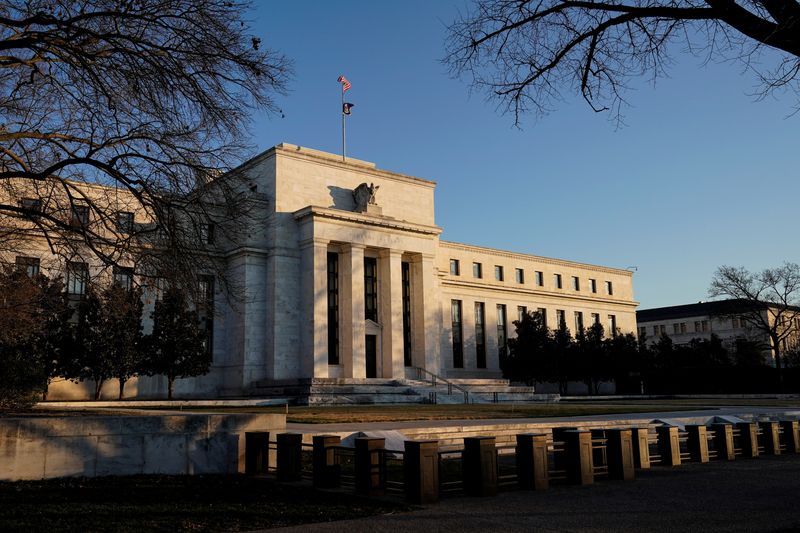Why traders aren’t buying the Fed’s ‘higher-for-longer’ vision
2023.09.25 06:14
2/2

© Reuters. The Federal Reserve building is seen before the Federal Reserve board is expected to signal plans to raise interest rates in March as it focuses on fighting inflation in Washington, U.S., January 26, 2022. REUTERS/Joshua Roberts
2/2
By Ann Saphir
(Reuters) – It’s a now-familiar dance: Federal Reserve officials signal to the world that interest rates are not dropping anytime soon. Financial markets respond with bets to the contrary.
That dynamic, which has played out repeatedly over the course of a U.S. central bank policy tightening regime that began 18 months ago, was back on full display last week.
Forecasts published on Wednesday by the U.S. central bank showed that a majority of its policymakers see the Fed’s benchmark overnight interest rate ending this year at 5.6%, which implies one more interest rate hike in the next three months. They also now anticipate an end-of-2024 policy rate of at least 5.1%, half a percentage point higher than they projected three months ago.
Meanwhile, interest rate futures contracts continue to price in only about a 50% chance of further tightening in 2023, and see a 4.65% policy rate by the end of next year.
And that disagreement over the policy trajectory, while not unusual, could complicate the Fed’s efforts to smother inflation, if easier financial conditions spur spending or investment that rekindles price pressures.
Here are three reasons why financial markets may be betting on more rate cuts next year than Fed policymakers say is likely to be in the cards:
INFLATION OPTIMISM
Inflation by the Fed’s preferred measure, the personal consumption expenditures price index, peaked in the summer of 2022 at 7% and had fallen to 3.3% this past July. With non-housing services inflation still sticky, Fed officials project underlying inflation pressures will ease only slowly from here.
Financial markets may be more optimistic about easing price pressures than the more guarded Fed policymakers.
“We continue to expect a faster pace of fed funds rate cuts than what the Fed currently projects, as we’re anticipating a faster pace of inflation reduction,” said Preston Caldwell, chief U.S. economist at Morningstar, predicting core PCE inflation will drop to 1.9% by the end of next year.
Fed policymakers see end-of-2024 core inflation at 2.6%.
GROWTH AND JOBS PESSIMISM
Fed Chair Jerome Powell, speaking last week after the end of a two-day policy meeting, said he and his colleagues’ new expectations for the policy rate path are shaped by the economy’s unexpected resilience to rate hikes so far.
The view of traders, and that of some economists, is that a faster loss of economic momentum and slowing jobs growth could forestall any further tightening and possibly trigger earlier policy easing next year.
“Given our view for slowing GDP growth in Q4, a shrinking imbalance between labor supply and demand, and still moderate core inflation, we continue to expect the (Federal Open Market) Committee to keep the fed funds rate unchanged at current levels,” TD Securities analysts wrote, referring to the central bank’s policy-setting committee.
Fed officials say their decisions will be guided by data that so far is delivering mixed signals, with continued labor market tightness even as the housing market appears to be weakening.
A menu of potential risks and shocks ahead complicates the outlook further, including the broadening of the United Auto Workers union’s coordinated strike against the three big Detroit automakers; the resumption of student loan repayments next month, which could take a bite out of household spending; and a rise in energy prices that, if sustained, could push inflation back up.
THE FED’S OWN UNCERTAIN FORECASTS
Fed policymakers plan to stop raising interest rates once they are convinced inflation is headed down to the central bank’s 2% target. “We haven’t gotten to a point of confidence about that yet,” Powell said last week.
They also plan to start cutting interest cuts well before inflation actually hits their goal, so as to prevent policy from becoming too restrictive given falling inflation.
Their latest quarterly forecasts imply they now feel they will need a higher inflation-adjusted “real” rate to adequately brake the economy and win the inflation battle.
But Powell also emphasized that the forecasts are highly uncertain, so it is little surprise that traders and economists are also expressing doubts.
“We see real rates flat in 2024,” Morgan Stanley analysts wrote, laying out a view for no more Fed rate hikes in 2023 and a full percentage point of cuts next year.
The market – in this cycle at least – has been wrong each time it doubted the Fed’s resolve and has had to come around to the central bank’s position eventually. Of course this time is somewhat different, with the Fed, by its own admission, essentially up against the end of its rate hikes. Next year’s direction is almost certainly lower, but the market has misjudged the cadence on the way up. It remains to be seen whether it will get it right on the way down.








